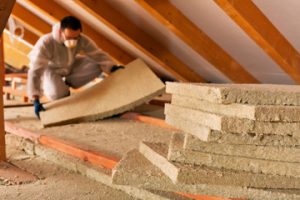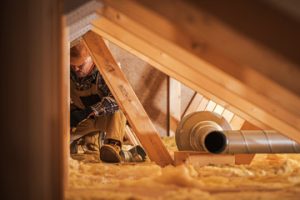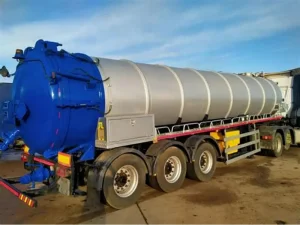Insulation Removal is a messy, dusty, and potentially dangerous process. Invest in appropriate protective gear like disposable coveralls, a mask, and gloves.

Old insulation can negatively impact your home by trapping moisture, fostering mold growth, or providing habitat for pests. Identifying and addressing these issues proactively can lower energy bills, enhance indoor air quality, and prevent health problems.
Insulation degrades and loses efficiency over time, and the materials may contain contaminants that pose health risks. The removal of old insulation and replacement with new materials can reduce these risks, improve indoor air quality, stabilize temperatures, and enhance energy savings.
Visible damage, degradation, or moisture are clear signs that it’s time to replace your insulation. Wet or moldy insulation must be removed immediately to prevent further damage and to ensure the safety of your home.
Moisture is insulation’s worst enemy. It can cause corrosion of metals and wood, slash thermal resistance, and foster the growth of harmful organisms. Leaks from roofs, plumbing, or poor ventilation can soak fiberglass insulation and other materials, creating a breeding ground for mold and mildew.
Pest infestations can also compromise the integrity of insulation. Rodents and insects often make their homes in attics and crawl spaces, where they leave droppings, urine, and nesting materials that contaminate the surrounding areas and pose health risks. Insulation removal helps eliminate pests and their habitats to safeguard your family’s health and safety.
The insulation removal process takes time, and you’ll need to be prepared with tools like a vacuum cleaner, rakes, a dustpan, sealed bags for disposal, and safety gear. It’s recommended to hire a professional to remove insulation for the best results. They’ll take the necessary steps to assess your existing insulation, identify any contaminants, and follow strict safety precautions during the removal and disposal of the materials. This detailed procedure can help you avoid unforeseen issues and get the most out of your energy-saving renovation project.
Moisture
Moisture in insulation is a big problem, affecting both its ability to insulate and your health. It can lead to mildew, mold and rot that damage the walls and ceilings of your home. Wet insulation can also attract rodents and other pests.
The best way to prevent moisture in insulation is to have it properly installed and maintained. Ensure that all voids and gaps are sealed to prevent the passage of water or air. It is also essential to ensure proper ventilation. Installing soffit vents, ridge vents and ductwork that are properly sized can help prevent insulation from becoming damp.
Insulation that is wet must be completely removed and thoroughly dried before it can be replaced. This should be done as quickly as possible to reduce the risk of structural damage and other health problems. In addition, wet insulation should be replaced with new material that is designed to withstand moisture.
Moisture in wall cavities can be caused by heavy rains, burst pipes and other issues. It can also result from poor insulation installation, including a lack of ventilation. If the underlying cause of the moisture is addressed, this should prevent future issues in the walls and ceilings of your home.
Damp insulation is a serious problem that compromises the effectiveness of your home’s energy efficiency upgrades and can be a breeding ground for mold growth. Insulation removal and replacement, along with a thorough air seal, can improve indoor air quality for a safer and healthier home. This is the ideal starting point for other energy-saving improvements. Contact iFOAM of O’Fallon to learn more about how you can make your home healthier and more efficient.
Pests
Insulation isn’t just an overlooked component of a home; it’s also one of the most important. It’s vital for energy efficiency, regulating indoor temperatures, and protecting your health and safety. However, without proper attic insulation and maintenance, it can provide an inviting environment for pests to take up residence and cause more damage to your home.
Pests can contaminate your insulation with their droppings and urine, creating a breeding ground for mold and bacteria that can affect the quality of air you breathe. It can also lead to serious health issues like respiratory conditions, allergies, and even infections. Professional teams start by inspecting the attic space to identify the source of the problem before removing and replacing your insulation.
The pests that infest your insulation can also create gaps and tunnels that reduce its ability to regulate temperatures. This results in higher energy bills and a less comfortable living space. It’s also common for pests to chew on wires that run through attic insulation, which is a fire hazard. If you notice signs of gnawing or shredded insulation, it’s time to replace your insulation.
While there are many reasons to have your old insulation removed, new pest-resistant insulation provides the best solution. It’s specially designed to repel pests and protect your attic space from their invasive habits, which can significantly reduce your heating and cooling costs and improve your comfort. It’s an investment in your home’s long-term safety and energy efficiency that will pay off for years to come.
Health
Insulation is a critical component to your home’s comfort and efficiency. But aging insulation can lead to problems like high energy bills, a drafty home, or even health concerns such as mold and dust mites. Fortunately, replacing your outdated or damaged insulation with new materials can solve these issues and improve your home’s overall performance.
But attempting to remove insulation yourself can be dangerous for homeowners. In addition to the physical risks, insulation removal requires shutting off and disconnecting any live electrical systems in your attic. Mishandling or accidentally cutting these wires can cause serious damage and injury. Professionals know how to safely handle and work around these systems, minimizing the risk of electrical damage or outages.
The physical and safety hazards of DIY insulation removal are compounded when the insulation is made of a hazardous material like asbestos or fibreglass. These materials, if disturbed or inhaled, can release harmful substances into the air that can lead to severe respiratory problems and other health issues. Professionals will use special tools and equipment to ensure that any hazardous materials are removed in a safe and controlled manner.
Depending on your location, you may be required to dispose of old insulation in accordance with local regulations. A professional insulation company will provide proper disposal services to avoid environmental harm and protect the safety of your family, pets, and the surrounding community.
Safety
The physical risks of tackling insulation removal oneself can be considerable, especially for a homeowner. Insulation is often located in hard-to-reach spaces like attics and crawl spaces, which can challenge a person’s manoeuvrability and increase the likelihood of falls or injury. Furthermore, these confined areas can pose structural hazards due to weakened walls or floors. Professionals have the experience and training to navigate these dangers safely, minimising the risk of harm.
Inhaling airborne insulation particles, mold, and other irritants is also a significant safety risk when removing attic insulation. It is therefore important to wear adequate personal protective equipment during the removal process, including a respirator mask, goggles, and gloves. Likewise, it is important to prepare the work area appropriately and set up ventilation to limit inhalation of harmful substances. Additionally, it is important to properly dispose of insulation materials to reduce environmental impact.
A professional insulation removal service will assess the existing material, identify any potential hazards, and prepare the work area for safe removal. This involves setting up ventilation and establishing containment zones to limit the spread of contaminants. In addition, specialized vacuum equipment is used to effectively remove loose-fill and batt insulation without dispersing dust and debris. Lastly, all removed insulation will be properly disposed of in accordance with local regulations and guidelines.




